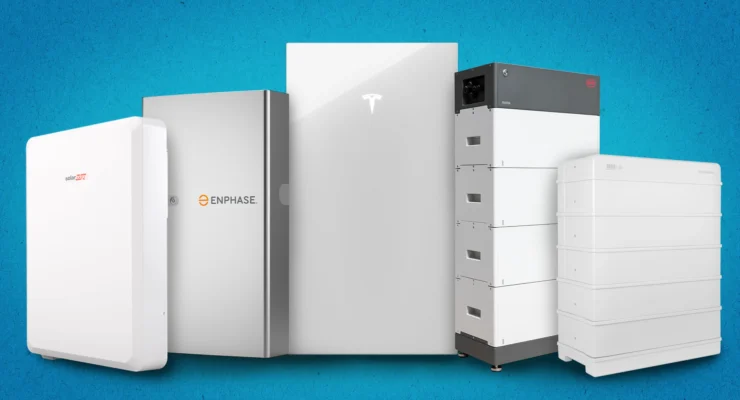Fast read
Solar storage batteries enhance any solar system, whether you choose a lead-acid or lithium battery.
Lead-acid batteries, invented in the 1800s, are common and cost-effective, used for solar energy, vehicles, and more. They are reliable but less efficient, with 80-85% efficiency.
Maintenance involves cleaning terminals and topping up distilled water. Their depth of discharge (DoD) is around 50%.
Lithium batteries, modern and efficient, were developed in 1912 and are popular in laptops and EVs. They offer 95% efficiency, charge faster, and require no maintenance because of built-in battery management systems. They have a higher DoD of 80% or more, providing more usable capacity.
Lithium batteries are superior in efficiency, maintenance, and capacity but are more expensive. Lead-acid batteries remain a solid, budget-friendly option. Choose based on your needs and budget for optimal solar energy storage.
Lead Acid Battery vs Lithium Battery: Understanding the Differences
Solar storage batteries are great for solar systems. They store energy from panels so you have power even when the sun isn’t out. When choosing a battery, you’ll encounter two main types: lead-acid and lithium.
Lead-acid batteries have been used in cars for over 100 years because they are reliable. They are generally cheaper upfront but have a shorter lifespan of around 3-5 years and require regular maintenance. They can only use a portion of their total battery capacity to prevent reducing their lifespan. This is because of their lower depth of discharge.
On the other hand, lithium batteries are a newer technology that is becoming increasingly popular for solar systems. They are more expensive upfront but offer a longer lifespan of 10-15 years and require little to no maintenance. Lithium batteries have a higher DoD, allowing you to use more of their capacity without affecting their lifespan. They are also more efficient, meaning they can store and release energy more effectively than lead-acid batteries.
Lead-Acid Batteries
History and Composition
Lead-acid batteries are the most common type of rechargeable battery, having been invented in the 1800s. They are not only used for solar energy storage but also for lighting, vehicles, and various other applications. Different types of lead-acid batteries exist, but they all contain sulfuric acid, water, and lead dioxide. This chemical makeup creates a reaction that can either discharge electricity or store it, making these batteries versatile and reliable.
Applications
Lead-acid batteries have been widely used in solar systems because of their proven technology and relatively low cost. They are great for off-grid solar systems and backup power because they can handle a lot of power.
Lithium Batteries
Modern Development
Lithium batteries are more modern than lead-acid batteries, with a significant increase in sales in the early 1990s after being developed in 1912. These batteries are commonly used in laptops, phones, and electric vehicles because of their lighter and smaller design. The electrodes within lithium batteries contain lightweight lithium and carbon, allowing the battery technology to store and export electricity efficiently without causing any external discharge.
Advantages in Solar Systems
Lithium batteries have become popular in solar systems because of their high energy density and efficiency. They can store more energy in a smaller space, making them ideal for residential and commercial solar installations.

What is the Difference?
Efficiency
The most important difference between lead-acid and lithium batteries is their efficiency. Lithium batteries are much more efficient, meaning that more of the solar power your system generates can be stored and used. Lead-acid batteries typically have an efficiency of 80-85%. This means that if your solar system absorbs 1,000 watts of solar energy, after the battery’s charging and discharging process, you’ll receive about 800-850 watts.
In contrast, lithium batteries have an efficiency of around 95%. If you used a lithium battery instead of a lead-acid one, you would have approximately 950 watts of power. This is 100-150 watts more power. This higher efficiency also means that lithium batteries charge faster.
Maintenance
Maintenance is crucial to ensure your solar system performs at its full potential, and this applies to solar batteries as well. Lead-acid battery maintenance may include cleaning the terminals to prevent corrosion. Monitoring the battery state to avoid sulfation, and topping up the distilled water in the battery. The amount of maintenance needed can vary, so it’s important to follow your installer’s recommendations.
In comparison, lithium batteries require no maintenance. If the battery has been installed correctly and in an appropriate location, it is essentially maintenance-free. Lithium batteries have an in-built battery management system (BMS) that monitors the life cycle, temperature, state of charge, and more, so you don’t have to worry about regular upkeep.
Depth of Discharge
The overall capacity used before recharging a battery is called the depth of discharge (DoD). Every battery type has a suggested depth of discharge (DoD), showing how much of its power can be used before recharging. Lead-acid batteries typically have a DoD of 50%, meaning you should only use half of their capacity to avoid reducing their lifespan.
Lithium batteries, on the other hand, have a DoD of 80% or more. This additional 30% means that lithium batteries offer a much higher usable capacity than lead-acid batteries. Furthermore, you’re less likely to shorten the lifespan of a lithium battery by using it more deeply compared to a lead-acid battery.
Conclusion
In short, lithium batteries are the best choice for storing solar energy compared to lead-acid batteries. They offer higher efficiency, less maintenance, and a better depth of discharge. However, their superior performance comes at a higher price.
If you don’t have the budget for a lithium battery, don’t be discouraged. Lead-acid batteries still provide significant benefits and are a great choice for solar energy storage. They have been a reliable option for many years and continue to serve well in various applications.
The decision to use a lead-acid battery or a lithium battery for your solar system depends on your specific requirements. It also depends on how much you are willing to spend and the level of performance you are aiming for. Both types of batteries have their advantages, and either can be a valuable addition to your solar energy setup.
Understanding the differences in solar energy systems is important. Prioritise your needs before making a decision. This will help you get the most out of your system.
Whether you choose a lead-acid battery or a lithium battery. You’ll be taking an important step towards sustainable and efficient energy use.



